Asus VG248QE: A 24-Inch, 144 Hz Gaming Monitor Under $300
Every performance-oriented gaming rig needs a speedy display to keep up with cutting-edge GPUs. Asus delivers up to 144 Hz with its VG248QE 24-inch TN-based monitor. Is its display performance as impressive as the company's sub-$300 price tag?
Results: Grayscale Tracking And Gamma Response
The majority of monitors, especially newer models, display excellent grayscale tracking (even at stock settings). It’s important that the color of white be consistently neutral at all light levels from darkest to brightest. Grayscale performance impacts color accuracy with regard to the secondary colors: cyan, magenta, and yellow. Since computer monitors typically have no color or tint adjustment, accurate grayscale is key.
Because of the issue we discovered with the Contrast control, we feel Standard is the best mode to use, regardless of whether you calibrate or not. We also recommend the User color temperature preset, even if you don’t adjust it.

The VG248QE’s grayscale runs towards blue at every brightness level. All measurement points have visible errors. Fortunately, blue errors are the least detrimental to image quality. The white point error we really don’t want to see is green, and there’s obviously no problem there.
The tracking is fairly linear, so it should dial in well with calibration.
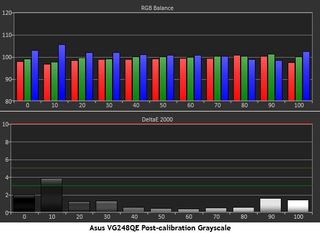
Aside from slight aberrations at 0, 10, and 100 percent brightness, this is an excellent chart and a significant improvement over the stock configuration. All the Delta E numbers are below two, except for 10 percent brightness. Forty through 80 are well under one.
Let’s bring our comparison group back into the mix.

The VG248QE is on the high side of average in this test. HP's E271i is exceptional, while the majority of monitors tested do have some visible grayscale error out of the box.
Stay on the Cutting Edge
Join the experts who read Tom's Hardware for the inside track on enthusiast PC tech news — and have for over 25 years. We'll send breaking news and in-depth reviews of CPUs, GPUs, AI, maker hardware and more straight to your inbox.
Things look much better after calibration.
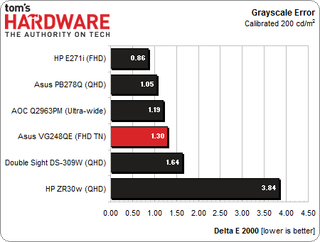
At a Delta E of 1.3, Asus demonstrates excellent calibrated performance. Even the most particular gamers will be more than satisfied with the grayscale accuracy of this monitor. Speed isn't its only strength. Rather, Asus offers solid performance in all areas.
Gamma Response
Gamma is the measurement of luminance levels at every step in the brightness range from 0 to 100 percent. This is important because poor gamma can either crush detail at various points or wash it out, making the entire picture appear flat and dull. Correct gamma produces a more three-dimensional image, with a greater sense of depth and realism. Meanwhile, incorrect gamma can negatively affect image quality, even in monitors with high contrast ratios.
In the gamma charts below, the yellow line represents 2.2, which is the most widely accepted standard for television, film, and computer graphics production. The closer the white measurement trace comes to 2.2, the better.
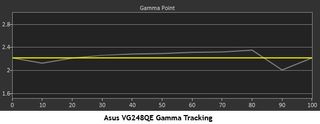
The VG248QE doesn’t have a gamma control. But apparently it doesn’t need one. The measurement trace stays nice and flat until 90 percent brightness, where it takes a bit of a dip. This is a slight error, and is only 1.34 cd/m2 higher than the target value. One thing we noted during the testing: at higher brightness settings, the gamma dip at 90 percent increases a little. For the best gamma performance, you’ll want to stick to around 200 cd/m2 max output.
Here’s our test group again for the gamma comparisons.
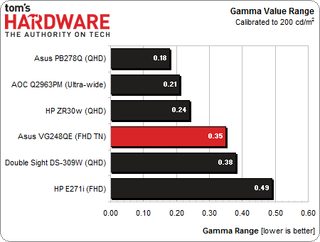
At a value range of .35, the VG248QE is squarely in the middle of this pack, and also mid-pack among the screens we've tested this year. In short, gamma tracking is very good (well below the point where it negatively impacts image depth or detail).
We calculate gamma deviation by simply expressing the difference from 2.2 as a percentage.
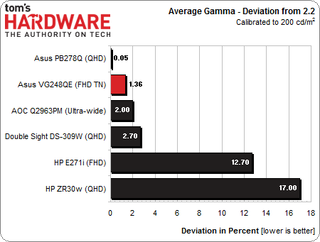
A variation of 1.36 percent puts Asus in second place today, and fifth overall. Numbers like these mean the VG248QE has no gamma issues to speak of. It tracks a 2.2 value well as long as you work around a max brightness level of 200 cd/m2 or less.
Current page: Results: Grayscale Tracking And Gamma Response
Prev Page Results: Brightness And Contrast Next Page Results: Color Gamut And Performance
Christian Eberle is a Contributing Editor for Tom's Hardware US. He's a veteran reviewer of A/V equipment, specializing in monitors. Christian began his obsession with tech when he built his first PC in 1991, a 286 running DOS 3.0 at a blazing 12MHz. In 2006, he undertook training from the Imaging Science Foundation in video calibration and testing and thus started a passion for precise imaging that persists to this day. He is also a professional musician with a degree from the New England Conservatory as a classical bassoonist which he used to good effect as a performer with the West Point Army Band from 1987 to 2013. He enjoys watching movies and listening to high-end audio in his custom-built home theater and can be seen riding trails near his home on a race-ready ICE VTX recumbent trike. Christian enjoys the endless summer in Florida where he lives with his wife and Chihuahua and plays with orchestras around the state.
-
ff6shadow I own this. Bought when it was first available. Great monitor for gaming. I use 2x GTX Titans with it.Reply -
SWEETMUSK if I have $300 dollars I will not buy for 24 inch "TN" screenReply
IPS is much better then TN -
Axonn People who think 144 Hz is more important than an 8-bit panel are in for a big, big fail.Reply -
ryude This monitor uses PWM (Pulse Width Modulation) for the backlight, which causing flickering. The only 144hz monitor that does not use PWM is the BenQ XL2420TE.Reply -
Plusthinking Iq they only sell BenQ XL2420T version in my country, so i bought the asus for the double pwm hz. pwm, the scourge og the lcd monitor.Reply -
CraigN ryude - yes, it uses PWM, however, as an owner of one of these monitors, I have not noticed any flickering at all. It's a really solid performing monitor. That same PWM comes in real handy when running in Lightboost mode for even more reductions to input lag.Reply
CaptainTom, 1ms makes a huge difference over 5ms. I didn't think it would at first until I bought one of these. Next to my old 24" HDTV that was my monitor for awhile, the difference is insane.
-
CraigN PS , Christian, your SmartBuy award photo at the end of the article is the wrong ASUS monitor ;) Also, would you guys mind releasing the ICC profile you guys calibrated for your tests?Reply
Most Popular

